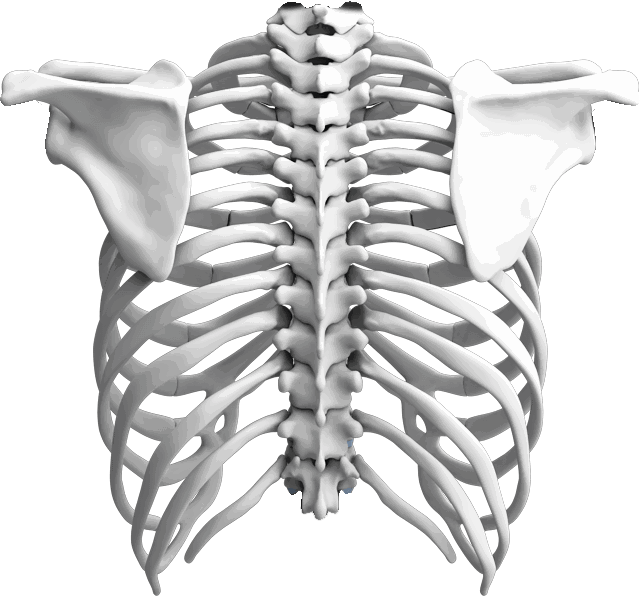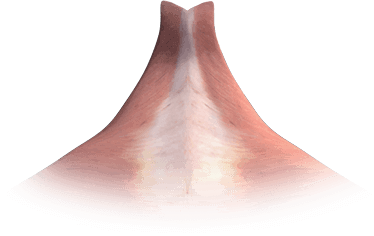Upper Neck 101
A Complex Problem
One of the most unique regions of the human spine is where the head meets the neck! Half of all of our head and neck movements occur between the head and top two vertebrae. Even subtle injuries can disrupt the normal balance of this region of the spine, sometimes in very large and complex ways! This potentially injures the connective tissue, ligaments and muscles responsible for maintaining normal head and neck alignment. The results from your personal history are demonstrated in the misalignment you see here. This is where the head, neck and top vertebra (atlas) have shifted sideways from their normal position. This causes stress and altered nerve communication to and from the brain, which also produces postural distortion and body imbalance as the entire spine shifts off center. See “How Did I Get This Way?”.
A Gentle solution to a complex problem:
Utilizing a very precise system of analysis developed by Dr. Ralph R. Gregory and the National Upper Cervical Chiropractic Association (NUCCA), which is based on math and physics, Dr. Hasick is able to calculate the personal reduction pathway and corrective force necessary to bring the head, neck and atlas back into proper alignment (represented by the correction arrow when you click on the animation) with very little force and no “twisting” or “popping” of the neck. It is so subtle that most patients don’t even feel the adjustment. As the optimal correction in the upper neck is achieved, the entire body is brought back into balance as stress on the brain stem (that controls body posture) is relieved. This is why people with a variety of problems, even in the lower part of their body, respond well to the NUCCA correction.
A Lasting Difference
The upper cervical misalignment is one of the most complex and difficult regions of the spine to align, but when the optimal correction is achieved, the results can be simply amazing. Patients notice changes throughout their entire body as the normal alignment and posture of their body is restored. It takes a tremendous amount of training to deliver an optimal NUCCA correction and Dr. Hasick has dedicated his life to the mastery of this procedure. He was board-certified by Dr. Gregory and has been involved in teaching and ongoing clinical research for many decades.
How Did I Get This Way?
As you can see here, injury also twists the upper neck adding to the complexity of the misalignment and compounding stress to the brainstem. The misalignment you see is the result of one or more past injuries. You had injuries that can likely be traced all the way back to childhood: The header off the top bunk, a tumble down the steps, the fall off the bike, hayloft, or backyard tree. Or perhaps it was that teenage gymnastics injury or auto accident? Sometimes when you think back, you’ll come up with a few possibilities of your own.
Regardless of the cause, many people are left with a neck misalignment and postural distortion by the time they reach adulthood. After the initial pain of an injury subsides, upper neck misalignment can remain pain-free for years until a more recent injury occurs or body imbalance finally takes its toll in the form of degenerative disc disease, arthritis and/or stenosis. See “How Does This Affect My Health”.
The Nervous System "Grand Central"
Across many years of in-depth research and hundreds of thousands of patients, we have seen that following an optimal NUCCA correction, positive changes occur in different areas of the body. The lower end of the brain is called the brainstem because it descends (neurologically) down into the upper neck. Every nerve that travels down the spinal cord has to pass through the small donut shaped vertebra that wraps around the brainstem called the “atlas”! For this reason, the upper neck is our neurological “Grand Central Station”! Here’s why it is so important:
Posture And Body Balance
The lower brainstem helps control normal posture and balance. Misalignment and stress in the upper neck causes the muscles along each side of the spine to pull unevenly and shift the entire body off centre. (See “The Bigger Picture” to learn how stress on these posture control centers affect the entire body.
Headaches and Migraines
Recent research on Migraines and Headaches is beginning to show how an upper neck misalignment impedes cerebral spinal fluid flow and blood flow in and out of the brain producing severe Migraine and Headaches! Years of clinical experience and the recent Calgary NUCCA Migraine Study showed that after an optimal NUCCA correction, very positive changes were experienced by many patients in terms of frequency, intensity and manageability of their pain . Even with long-standing frequent pains.
Concussion and Neck Injury
You cannot have a head injury without a neck injury. They are intimately connected!
A concussion is a significant and sometimes serious event involving the neck, head and brain. Given the right care and enough time to properly rest and recuperate, the brain can fully recover from such an injury. NUCCA care is an important ingredient in encouraging complete recovery.
Sleep / Mood
Serotonin is a chemical produced in the lower brain stem. Serotonin influences various functions, including regulation of mood, sleep, appetite, muscle contraction, and some cognitive functions including memory and learning. Upper neck misalignment causing stress on the lower brain stem can have a dramatic affect on a person’s energy and overall sense of “aliveness” as is the case with Chronic Fatigue Syndrome and Fibromyalgia. Many patients noticed significant changes in their mood and sense of well-being after their NUCCA spinal correction.
Immune Function
The Autonomic Nervous System (ANS) controls all of the body functions that we don’t have to think about. The Sympathetic Nervous System is that part of our ANS that becomes more active during times of stress and is often called the fight-or-flight response. Upper neck misalignment creates an imbalance with the ANS that includes the Parasympathetic and Sympathetic Nervous System. When the upper spine is imbalanced, this problem is shown to suppress the body’s Immune System.
Digestion
The Vagus nerve is very influential in regulating digestion and elimination. This important nerve is often affected by misalignment of the upper neck because it passes right next to the atlas vertebra as it comes down from the brain.
Blood Pressure, Respiration and Heart Rate
The neurological centers for control of these body functions are located in the lower brain stem and can be adversely affected by upper neck misalignment. Recent research has proven the NUCCA correction helps people with high blood pressure. NUCCA Hypertension Study
The Bigger Picture
Injury to the upper neck has a global affect on the body. When the head shifts off the top of the neck due to injury, the body’s “righting reflex” moves the body into a distorted posture to bring the head back to level. This shift causes stress and miscommunication affecting posture control centers in the lower brainstem where it passes through the top vertebra. Posture muscles that run along one side of the spine pull harder than muscles on the other side resulting in the picture you see here.
Body imbalance has a very negative long-term effect on spinal discs. When the body’s weight is not distributed evenly across the discs, premature degenerative disc disease, herniation and even a closing down of spinal nerve canals (stenosis) can result. Just as driving your car with the front end out of align causes premature tire wear, long term body imbalance causes your spine to age quicker. The difference between a 75 year-old on the golf course and a 75 year-old pushing a walker is often found in their years of consistent spinal care and healthy lifestyle!
Notice the short leg, uneven hips, high shoulder and head tilt. Look closely at your friends and family as they face you and you may be able to tell if they should be referred for an evaluation. Click the animation to see how a small strategic touch just under your ear restores balance and alignment to the entire spine!
How Does This Affect My Health?
The brain and nervous system controls and regulates every function of the body, most of which we don’t consciously think about, such as heart rate, breathing, digestion, etc. That is why the nervous system is the very first body part to develop in the mother’s womb. To live in complete health, the spine must protect the nervous system so that every cell in the body is 100% connected to the brain. Injury and damage to the spine itself interrupts the flow of energy to and from the brain. The common term for this nerve stress caused by misalignment of the spine is subluxation. As stated earlier, the upper neck is especially vulnerable to injury and subluxation. Combined with the fact that the brainstem, which is the nervous system’s “Grand Central Station”, passes through the first cervical vertebra, problems here tend to have a more detrimental effect on the body.
- Misalignment of the spine can cause direct pressure on the spinal cord and/or the delicate nerves that exit between each vertebrae of the spine. As a result, any body part served by these nerves that loses its flow of energy to and from the brain will not function properly. For example, if the nerve that supplies the stomach is stressed, problems such as indigestion, heartburn, reflux, bloating and gas can occur.
- Body imbalance creates an ongoing structural and neurological stress to the body. The body responds to stress by activating the sympathetic nervous system. Long-term sympathetic nervous system activity has been proven to cause the immune system to be suppressed. In other words, your immune system doesn’t work as well when the body is under long-term stress and imbalance.
- Long term body imbalance causes premature aging and degeneration of the spine itself. Arthritis is the more common term for this wear and tear. As spinal degeneration becomes advanced, the vertebrae themselves encroach upon the spinal nerves causing them to slowly lose their ability to transmit vital brain messages. Doctors refer to this condition as spinal stenosis.
Is Your Spine Older Than You?
Our human body is capable of being very healthy as we continue to age! We just need to care for it properly. Unfortunately, many people are robbed of their “golden years” by a spine that ages prematurely. It seems that most people understand more about taking care of their teeth than their spine! This is why we spend so much time educating you on how to care for your spine. It is just really good “Spinal Hygiene”. The progression of spinal degeneration can be optional and not a given as we age. Here is some information below based upon the NUCCA X-Ray exam we perform of you at our clinic and would give you an idea of where you are at.
Phase I: 5-15 Years of Spinal Adaptation
Spinal trauma that remains uncorrected, can result in the loss of the normal curve, slight disc narrowing and subtle spine and nerve dysfunction. Because the body is so intelligent and adaptable, this early phase can exist without the warning of pain or other obvious symptoms. However, if left uncorrected, over time the degenerative process continues.
Common symptoms of Phase I Degeneration include:
- Headaches
- Neck Stiffness and Pain
- Strained Muscles
- Shoulder Tension
Phase II: 15-30 Years of Adaptation
This would be recognized on the x-rays we take to see if there are visible bone spurs and rough edges seen on your vertebrae. Abnormal bony growths distort the shape and function of the vertebrae and cause imbalanced movement to stress discs, joints and ligaments. A breakdown of these soft tissues over time can result in a lack of normal joint movement, inflammation and potential interference to normal nerve function.
Common symptoms of Phase II Degeneration include:
- Osteo-Arthritis
- Degenerative Disc Disease (DDD)
- Degenerated Facet Joints
- Pain, Headaches, Fatigue and other spinal symptoms
- Chronic Joint Pain
- Neck Stiffness and Pain
Phase III and IV : 30+ Years of Adaptation
A well seasoned spine with a lifetime of chronic joint stress may cause the eventual fusion of the malfunctioning joints. Atrophy, nerve damage and soft tissue degeneration are often prevalent. With reduced mobility and impaired nervous system function, there can result a diminished quality of your life.
Common symptoms of Phase III and IV Degeneration include:
- Chronic Regional Pain
- Spine stenosis
- Extreme stiffness and joint pain
Regardless of which phase you may be, regular care is helpful and important. Maintaining your optimal spinal alignment, daily stretching and movement practices, adequate hydration and water, good nutrition, good sleep and rest, stress management and personal meaningful renewing time all contribute to maintaining good function and a great quality of life.
“Helping You Maintain a Healthy Balance for Life”
Dr. Gordon Hasick
#201-5005 Elbow Dr. SW
Calgary, Alberta
T2S 2T6













































































